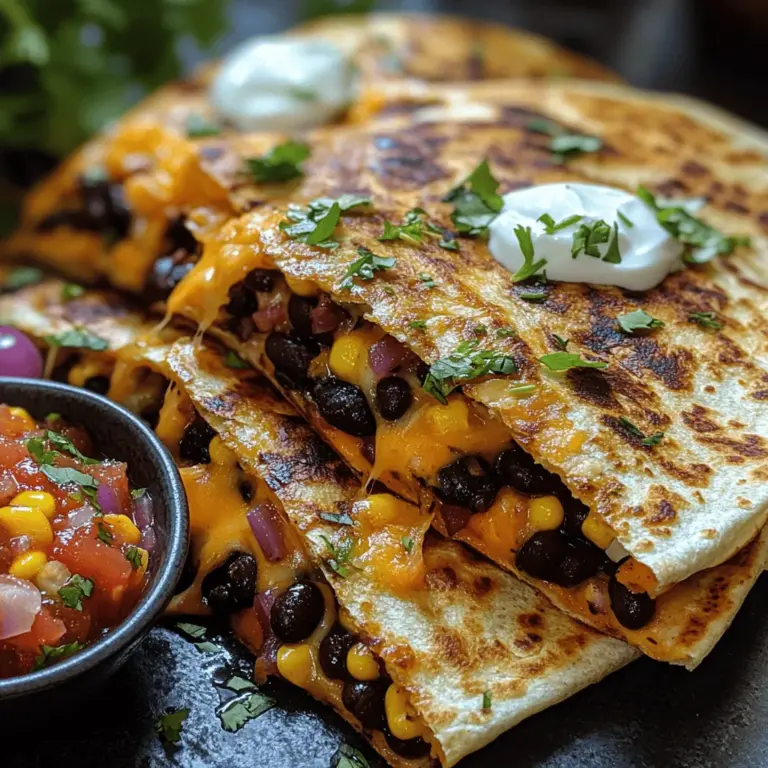Introduction
There’s something undeniably comforting about a hearty bowl of beef stew. Whether it’s a chilly evening or a family gathering, this dish has a way of warming hearts and filling bellies. The rich aroma of slow-cooked beef mingling with savory vegetables creates a welcoming atmosphere that beckons everyone to the table. What makes this comforting classic even more enticing is the convenience of using a slow cooker. With minimal prep time and a hands-off cooking process, you can set it and forget it, allowing the flavors to meld beautifully over hours of cooking.
This savory slow cooker beef stew is not just about convenience; it’s also about wholesome ingredients that elevate the dish from ordinary to extraordinary. Tender chunks of beef, vibrant vegetables, and a rich, flavorful broth come together to create a meal that’s perfect for any occasion. Whether you’re preparing a family dinner, hosting friends, or simply craving something hearty, this beef stew is sure to impress.
Understanding the Ingredients
The Role of Beef in Stew
At the heart of any good beef stew lies the beef itself. Choosing the right cut of meat is crucial for achieving that melt-in-your-mouth tenderness that everyone loves. The best cuts for slow cooking are those that have a good amount of marbling and fat content, which breaks down during the long cooking process, infusing the stew with rich flavor.
Best Cuts for Slow Cooking: Chuck Roast vs. Brisket
When it comes to slow-cooked beef stew, two of the most popular choices are chuck roast and brisket. Chuck roast, often referred to as chuck eye or shoulder, is a classic choice thanks to its balance of meat and fat. It becomes incredibly tender after several hours in the slow cooker, making it ideal for this dish. On the other hand, brisket, which comes from the lower chest of the cow, also works well but may require slightly more attention to prevent it from becoming too dry.
In general, chuck roast is the go-to for traditional beef stew, while brisket can add a unique flavor profile if you’re looking to try something different.
Vegetables That Enhance Flavor
While the beef takes center stage, vegetables play a crucial supporting role in adding flavor, texture, and nutrition to your stew.
Classic Choices: Carrots, Potatoes, and Onions
When thinking about vegetables for beef stew, carrots, potatoes, and onions are the staples that you can’t overlook. Carrots add a natural sweetness, potatoes offer a hearty texture, and onions provide a savory base that enhances the overall flavor.
Additionally, these vegetables hold up well during the long cooking process, retaining their shape and infusing the broth with their flavors.
The Benefits of Adding Garlic, Celery, and Herbs
To elevate your beef stew even further, consider adding garlic for a robust flavor kick, celery for an aromatic freshness, and a selection of herbs such as thyme, rosemary, or bay leaves. These ingredients not only enhance the stew’s taste but also contribute to its aromatic profile, making each bowl a fragrant delight.
Incorporating fresh herbs at the beginning of cooking allows their flavors to meld into the stew beautifully, while adding a sprinkle of fresh herbs just before serving can provide a burst of freshness.
The Power of Broth and Seasonings
A great beef stew wouldn’t be complete without a flavorful broth to bring everything together. The type of broth you choose can make a significant difference in the taste of your stew.
Types of Broth: Beef vs. Chicken
Most traditional recipes call for beef broth, which enhances the meaty flavor of the stew. However, chicken broth can also be used if you’re looking for a lighter option. Regardless of your choice, ensure that the broth is low-sodium to allow for better control over the seasoning of your stew.
Essential Spices and Herbs for Depth of Flavor
In addition to broth, adding spices and herbs is essential for depth of flavor. Common seasonings include salt, black pepper, and perhaps a hint of paprika or cayenne pepper for a touch of heat. A bay leaf is a classic addition that imparts a subtle earthiness. Don’t forget to taste and adjust your seasonings as the stew cooks, allowing the flavors to develop fully.
Optional Add-ins for Extra Flavor
For those looking to add an extra layer of flavor, consider incorporating a splash of red wine or beer into the mix. These ingredients can enhance the richness of the stew and add complexity to the flavor profile. Additionally, feel free to toss in some peas, mushrooms, or other seasonal vegetables for variety and nutrition.
Preparing Your Slow Cooker Beef Stew
Now that we’ve covered the key ingredients, it’s time to prepare your slow cooker beef stew. A little preparation goes a long way in ensuring a delicious result.
Gathering Your Ingredients
Before diving into the cooking process, gather all your ingredients. This not only streamlines the cooking experience but also helps you ensure you have everything you need on hand.
Tips for Selecting Fresh Produce and Quality Meat
When selecting produce, look for vibrant vegetables that are free of blemishes. Freshness is key to achieving a flavorful stew. For the beef, choose high-quality cuts from a reputable butcher or grocery store. Look for marbling in the meat, which indicates tenderness.
Importance of Measuring Ingredients Accurately
Accurate measurements are crucial in cooking, especially in recipes like stew where the balance of ingredients can affect the final taste. Use measuring cups for liquid ingredients and a kitchen scale for meat to ensure consistency.
Prepping the Beef
With your ingredients ready, it’s time to prep the beef. Proper cutting techniques and seasoning are vital for the best results.
Cutting Techniques for Uniform Cooking
Start by cutting the beef into uniform chunks, roughly 1 to 1.5 inches. This ensures that all pieces cook evenly and become tender at the same rate.
Seasoning and Browning the Meat: Why It Matters
While you can throw the raw meat directly into the slow cooker, browning it first in a pan can add a depth of flavor that enhances the overall dish. Season the beef with salt and pepper before searing it in a hot skillet with a little oil. Aim for a nice brown crust on all sides, which will contribute rich flavors to your stew.
Chopping the Vegetables
Once the beef is prepped, it’s time to chop the vegetables.
Techniques for Even Cuts
For even cooking, cut your vegetables into similar sizes. Carrots can be sliced into rounds, while potatoes can be diced into cubes. Onions should be chopped finely to ensure they cook down properly.
Timing Considerations for Different Vegetables
Keep in mind that different vegetables have varying cooking times. Potatoes and carrots hold up well in the slow cooker, while onions and garlic can be added later in the cooking process to maintain their flavor.
Assembling the Stew in the Slow Cooker
With all your ingredients prepped, it’s time to assemble your stew in the slow cooker.
Layering Ingredients for Optimal Flavor Infusion
When putting everything into the slow cooker, start with the beef at the bottom, followed by the heartier vegetables like potatoes and carrots. This layering allows the juices from the beef to seep down and flavor the vegetables as they cook.
The Order of Adding Ingredients: When to Add Herbs and Spices
Add any herbs and spices early in the cooking process to allow them to infuse their flavors throughout the stew. However, if you’re using fresh herbs, consider adding them towards the end of the cooking time to preserve their bright flavors.
With all these steps complete, you’re just about ready to enjoy a delicious, comforting bowl of slow cooker beef stew that’s bursting with flavors and warmth. Stay tuned for the next part, where we’ll delve into the cooking process and tips for achieving the best results.

Cooking Your Beef Stew
Setting Up Your Slow Cooker
To begin your slow cooker beef stew, it’s essential to set up your slow cooker properly. Start by placing the appliance on a flat, heat-resistant surface. Ensure that it is plugged in and that the cooking pot is securely seated in the base. Gather all your ingredients in advance to streamline the cooking process. This includes your cubed beef, chopped vegetables, broth, herbs, and spices. Having everything ready will allow you to layer the flavors effectively as you build your stew.
Choosing the Right Cooking Time: Low vs. High Settings
When it comes to cooking time, slow cookers offer flexibility with low and high settings. If you have time, opt for the low setting, which typically takes about 8 hours. This gentle cooking method allows the flavors to meld beautifully and results in tender beef. However, if you’re pressed for time, the high setting is also effective, cooking the stew in around 4 hours. Regardless of your choice, ensure that the beef is tender and the vegetables are cooked through by the end of the cooking cycle.
Importance of Keeping the Lid Closed for Even Cooking
One of the most critical aspects of slow cooking is to keep the lid closed during the cooking process. Each time you lift the lid, you release steam and heat, which can significantly increase the cooking time and alter the final texture of your stew. Trust the process; your ingredients will simmer gently, allowing the flavors to develop and the beef to become melt-in-your-mouth tender.
Monitoring the Cooking Process
While your beef stew is simmering, it’s a good idea to monitor the cooking process. After the first couple of hours, you might be tempted to check on your dish. You can do this by observing the bubbles through the lid rather than lifting it. If the stew is bubbling gently, everything is progressing as it should. If you notice it bubbling too aggressively, you may need to adjust the temperature.
Signs Your Stew Is Cooking Properly
As your beef stew cooks, look for visual cues indicating it’s on the right track. The meat should be browning and tenderizing, while the vegetables should begin to soften. You can also check the consistency of the broth; it should thicken slightly as the cooking time progresses, thanks to the collagen released from the beef. If you notice it’s too watery, you can remove the lid for the last hour of cooking to allow some of the moisture to evaporate.
Adjusting Seasoning During Cooking
Seasoning is crucial for a flavorful beef stew. After the first few hours of cooking, taste the broth. This is your opportunity to adjust the seasoning. If you feel it needs more salt, pepper, or herbs, add them gradually. Remember, it’s easier to add than to take away, so start with a small amount and build from there. If you’re adding fresh herbs, consider doing so in the last hour of cooking to preserve their vibrant flavors.
Serving Suggestions
Ideal Accompaniments for Beef Stew
When serving beef stew, consider complementary sides that enhance the dish without overwhelming it. A classic choice is crusty bread or flaky biscuits, perfect for dipping into the rich broth. You can either bake them fresh or serve them warm from the store.
Fresh Salads to Balance the Meal
To balance the hearty nature of the stew, a light, fresh salad is an ideal accompaniment. A simple green salad dressed with a vinaigrette can cut through the richness of the stew, offering a refreshing contrast. Ingredients like arugula, cherry tomatoes, and cucumbers work well, providing both color and texture.
Creative Serving Options
For a creative twist, consider serving your beef stew in a bread bowl. This rustic presentation not only looks appealing but also adds an extra layer of flavor as the bread absorbs the savory broth. Additionally, pairing the stew with a side of rice or creamy mashed potatoes can make the meal even more satisfying. Both options are excellent for soaking up the delicious sauce.
Storing and Reheating Leftovers
Best Practices for Storing Beef Stew
If you find yourself with leftover beef stew, proper storage is key to maintaining its flavor and texture. Allow the stew to cool to room temperature before transferring it to airtight containers. For short-term storage, place the containers in the refrigerator. For longer storage, consider freezing the stew to extend its shelf life.
How to Cool and Store in the Fridge or Freezer
To cool and store your beef stew, use shallow containers to allow for quicker cooling. Once cooled, cover the containers tightly before placing them in the fridge, where they can stay fresh for up to 3-4 days. If you choose to freeze the stew, make sure to leave some space at the top of the container, as liquids expand when frozen.
Recommended Containers for Freshness
When it comes to selecting containers, opt for glass or BPA-free plastic containers that are freezer-safe. Glass containers are excellent for reheating since they can go directly from the freezer to the microwave or oven. Ensure that lids are snug to prevent freezer burn.
Reheating Tips
To reheat your beef stew while preserving its flavor and texture, there are a few methods to consider. The stovetop is the best option, as it allows for even heating. Place the stew in a pot over medium heat, stirring occasionally until heated through. If you’re using a microwave, transfer the stew to a microwave-safe bowl, cover it loosely, and heat in short bursts, stirring in between.
Best Methods for Reheating to Maintain Flavor and Texture
Regardless of the reheating method, check the temperature to ensure it reaches at least 165°F (74°C). After reheating, taste the stew once again. You may find that the flavors have mellowed, so don’t hesitate to adjust the seasoning with a pinch of salt, pepper, or fresh herbs.
Nutritional Benefits of Beef Stew
Nutritional Profile Overview
Beef stew is not just comforting; it’s also packed with nutrition. A typical serving contains a balance of proteins, vitamins, and minerals that contribute to a well-rounded diet. The main ingredient, beef, provides a rich source of protein, which is essential for muscle repair and overall body function.
Highlighting Protein Content from Beef
A serving of beef stew can deliver a substantial amount of protein, which helps you feel full and satisfied. Protein is vital for building and repairing tissues, making it an important component of a healthy diet. Depending on the cut of beef you use, the protein content can vary, but most cuts used in stews provide a good amount.
The Importance of Vitamins from Vegetables
The vegetables in your beef stew add not only flavor but also a wealth of vitamins and minerals. Common additions such as carrots, potatoes, and onions contribute essential nutrients like vitamin A, potassium, and fiber. These components work together to support digestive health and boost your immune system.
Balanced Meal Considerations
When enjoying beef stew, keep in mind that it is a complete meal with proteins, carbohydrates, and fats. This balance makes it an excellent option for a satisfying dinner. To keep your meal nutritious, be mindful of portion sizes, especially if you’re pairing the stew with additional sides.
Portion Control Tips for Enjoying Without Overindulging
To avoid overindulging, serve your beef stew in smaller bowls, and accompany it with a side salad or bread rather than filling your plate entirely. This way, you can enjoy the rich flavors without going overboard, promoting a more mindful eating experience.
Conclusion
Slow cooker beef stew is a comforting classic that brings warmth and satisfaction to any table. Its convenience, with minimal hands-on time and the ability to produce rich flavors, makes it a cherished family recipe. The versatility of ingredients allows you to experiment with various vegetables and seasonings, tailoring the dish to your taste preferences.
Whether you’re sharing it with family on a cozy evening or preparing a meal for busy weekdays, beef stew is a reliable go-to. Embrace the opportunity to make it your own, exploring different variations and accompaniments that elevate this dish from simple comfort food to a delightful culinary experience.


